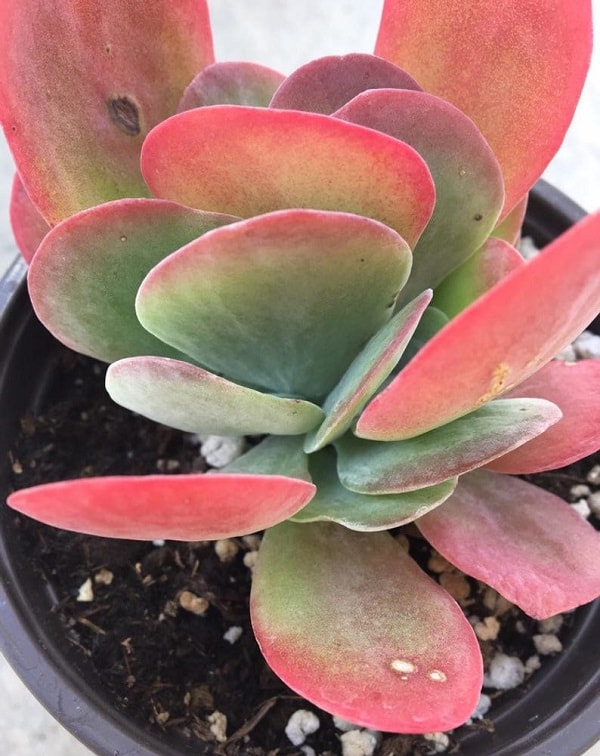The kalanchoe Luciae “Flapjack Succulent”is a Phanerógama species of Kalanchoe, which belongs to the family Crassulaceae, which is native to South Africa and Lesotho.
Features
It is a succulent that produces a 1m high stake, dying after having bloomed.
The kalanchoe luciae can reach up to 6 cm (2 feet) tall, and its leaves can measure 15 cm high and 10 cm wide.
They are gray with green or yellowish-green, with the red margin.
The leaves of the kalanchoe luciae, can also become totally red, especially if they are exposed to very cold.
It forms a basal rosette with large, rounded, fleshy leaves, without peduncles, with a coating of an off-white fluff.
The inflorescence is terminal and erect with dense and gathered flowers, waxy, greenish with yellow recurred lobes.
Tips to take care of the Kalachoe Luciae “Flapjack Succulent”
It is easy to grow, but if you want to maintain its beauty, it realy needs exposure with direct or partial sun; otherwise, its foliage remains green and the internodes of the stem become too long.
Temperature:
The kalanchoe luciae is a succulent that does not withstand much cold (it does not withstand temperatures exceeding -6.7 ° C).
That is why it is important if you live in a very cold area, half the plant in a course that can take you inside.
The ideal temperature for the plant is to sow it in a partial leftover (6 hours of sunshine a day).
But if you have long winters here I tell you how to care for succulents in winter.
Substratum:
The substrate (soil) must have excellent drainage since the roots of succulents are very susceptible to rot by water accumulation.
They also develop in nutrient-poor soils, composed of equal parts of silt and sand, with a pumice stone or lava sand to ensure good drainage.
Or a special mixture of cactus type 1/3, 1/3 of garden soil, 1/3 of coarse sand.
Watering:
Like other succulents, the kalanchoe luciae does not need so much irrigation, since, this plant is resistant to drought.
They should only water the plant when the substrate is completely dry.
It is important to avoid waterlogging since as we mentioned earlier, succulents are very delicate when it comes to excess water.
And in winter try to water the plant as little as possible.
Fertilizer:
It is good to fertilize the plant during its growth, and stop the fertilizer during the fall season.
Plagues and diseases:
Kalanchoe luciae can present problems with snails and slugs that can permanently abuse the leaves.
Another problem that may appear in the plant is rotting at the base of its leaves, which is caused by an excess of irrigation or a fertilizer very rich in nitrogen.
You just have to remove rotten leaves from the plant so that it does not affect the other leaves.
Flowering:
Blooms from autumn to spring.
Propagation:
Although it is a Crassulaceae, leaf cuttings are very difficult to achieve.
On the other hand, stem sections, or base root rejections very easily during the summer.
But after getting the cut, they should let the cut rest for a few days, before planting it.
The fine seeds germinate between 20 and 35 ° C, they are simply deposited on damp ground, covered with plastic, in light shade.
As soon as they sprout, the plastic is removed.
Something very curious about the kalanchoe luciae, is that it is often confused with the Kalanchoe thyrsiflora.
These two succulents are closely related but have some differences.
When Kalanchoe luciae is exposed to the sun a lot, it becomes redder, while Kalanchoe thyrsiflora is lighter green.
Conclusion
As I said many times it is always good to have succulents in your home and in this case this is a very particular one that I know you will enjoy.
I hope this article has been very helpful.
